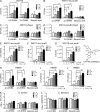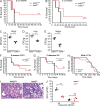Regulation of mammalian siderophore 2,5-DHBA in the innate immune response to infection
- PMID: 24863067
- PMCID: PMC4042634
- DOI: 10.1084/jem.20132629
Regulation of mammalian siderophore 2,5-DHBA in the innate immune response to infection
Abstract
Competition for iron influences host-pathogen interactions. Pathogens secrete small iron-binding moieties, siderophores, to acquire host iron. In response, the host secretes siderophore-binding proteins, such as lipocalin 24p3, which limit siderophore-mediated iron import into bacteria. Mammals produce 2,5-dihydroxy benzoic acid, a compound that resembles a bacterial siderophore. Our data suggest that bacteria use both mammalian and bacterial siderophores. In support of this idea, supplementation with mammalian siderophore enhances bacterial growth in vitro. In addition, mice lacking the mammalian siderophore resist E. coli infection. Finally, we show that the host responds to infection by suppressing siderophore synthesis while up-regulating lipocalin 24p3 expression via TLR signaling. Thus, reciprocal regulation of 24p3 and mammalian siderophore is a protective mechanism limiting microbial access to iron.
© 2014 Liu et al.
Figures







Comment in
-
Microbial hijacking of mammalian iron shuttling.J Exp Med. 2014 Jun 2;211(6):1009. doi: 10.1084/jem.2116insight3. J Exp Med. 2014. PMID: 24890116 Free PMC article. No abstract available.
Similar articles
-
Impaired neutrophil function in 24p3 null mice contributes to enhanced susceptibility to bacterial infections.J Immunol. 2013 May 1;190(9):4692-706. doi: 10.4049/jimmunol.1202411. Epub 2013 Mar 29. J Immunol. 2013. PMID: 23543755 Free PMC article.
-
A mammalian siderophore synthesized by an enzyme with a bacterial homolog involved in enterobactin production.Cell. 2010 Jun 11;141(6):1006-17. doi: 10.1016/j.cell.2010.04.040. Cell. 2010. PMID: 20550936 Free PMC article.
-
Lipocalin 2 mediates an innate immune response to bacterial infection by sequestrating iron.Nature. 2004 Dec 16;432(7019):917-21. doi: 10.1038/nature03104. Epub 2004 Nov 7. Nature. 2004. PMID: 15531878
-
Siderophores in Iron Metabolism: From Mechanism to Therapy Potential.Trends Mol Med. 2016 Dec;22(12):1077-1090. doi: 10.1016/j.molmed.2016.10.005. Epub 2016 Nov 4. Trends Mol Med. 2016. PMID: 27825668 Free PMC article. Review.
-
Neutrophil gelatinase-associated lipocalin, a siderophore-binding eukaryotic protein.Biometals. 2006 Apr;19(2):211-5. doi: 10.1007/s10534-005-3251-7. Biometals. 2006. PMID: 16718606 Review.
Cited by
-
The role of iron in host-microbiota crosstalk and its effects on systemic glucose metabolism.Nat Rev Endocrinol. 2022 Nov;18(11):683-698. doi: 10.1038/s41574-022-00721-3. Epub 2022 Aug 19. Nat Rev Endocrinol. 2022. PMID: 35986176 Review.
-
Offense and Defense in Granulomatous Inflammation Disease.Front Cell Infect Microbiol. 2022 Jun 29;12:797749. doi: 10.3389/fcimb.2022.797749. eCollection 2022. Front Cell Infect Microbiol. 2022. PMID: 35846773 Free PMC article. Review.
-
Iron Acquisition Systems of Gram-negative Bacterial Pathogens Define TonB-Dependent Pathways to Novel Antibiotics.Chem Rev. 2021 May 12;121(9):5193-5239. doi: 10.1021/acs.chemrev.0c01005. Epub 2021 Mar 16. Chem Rev. 2021. PMID: 33724814 Free PMC article. Review.
-
The Iron Tug-of-War between Bacterial Siderophores and Innate Immunity.J Innate Immun. 2019;11(3):249-262. doi: 10.1159/000494627. Epub 2019 Jan 3. J Innate Immun. 2019. PMID: 30605903 Free PMC article. Review.
-
New Insights into Aspirin's Anticancer Activity: The Predominant Role of Its Iron-Chelating Antioxidant Metabolites.Antioxidants (Basel). 2024 Dec 29;14(1):29. doi: 10.3390/antiox14010029. Antioxidants (Basel). 2024. PMID: 39857363 Free PMC article. Review.
References
-
- Albrecht-Gary A.M., Crumbliss A.L. 1998. Coordination chemistry of siderophores: thermodynamics and kinetics of iron chelation and release. Met. Ions Biol. Syst. 35:239–327 - PubMed
-
- Aung H.T., Schroder K., Himes S.R., Brion K., van Zuylen W., Trieu A., Suzuki H., Hayashizaki Y., Hume D.A., Sweet M.J., Ravasi T. 2006. LPS regulates proinflammatory gene expression in macrophages by altering histone deacetylase expression. FASEB J. 20:1315–1327 10.1096/fj.05-5360com - DOI - PubMed
Publication types
MeSH terms
Substances
Grants and funding
LinkOut - more resources
Full Text Sources
Other Literature Sources
Medical
Molecular Biology Databases

